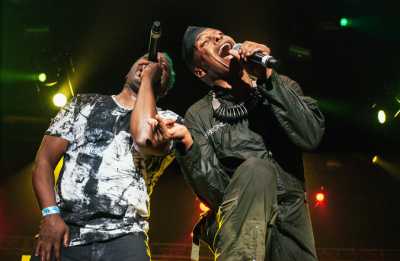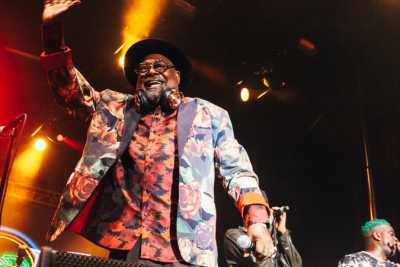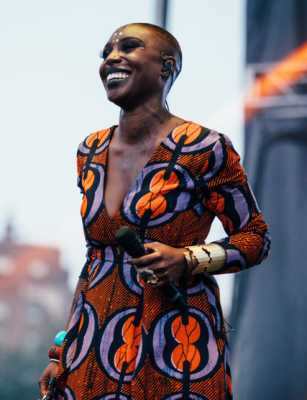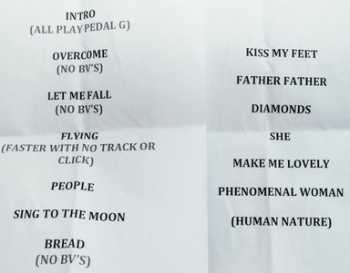|
Taken from The New York Times (Aug 30, 2016)
The Magic Formulas Behind the Set Lists at Afropunk Fest
by SARA ARIDI and LAURYN STALLINGS

Thundercat performing at Afropunk Fest.
Credit: Nicole Fara Silver for The New York Times |
Before there was Afropunk Fest, there was “Afro-Punk” — the 2003 documentary from James Spooner that helped open up a conversation about where race, identity and punk music intersect. The festival — a weekend gathering at Commodore Barry Park in Fort Greene, Brooklyn — came two years later, after Mr. Spooner joined Matthew Morgan, a music industry self-starter, in an effort to put a spotlight on black music and art that often falls outside of the mainstream.
Now in its 12th year, the Afropunk Fest has grown from a celebration of film, music, dance, skate culture and visual art into a movement. And several musicians who performed there over the weekend said despite shifts in focus over the years — it is now more a catchall for nonconformists who find a home in the nest of alternative urban culture — it remains unlike any other live-music event.
“Afropunk actually speaks to black youth. Youth of all colors, but really, directly to black youth,” said John Norwood Fisher, the bassist for Fishbone, who performed on Sunday night.
Making a set list for the festival took on special resonance for the British soul singer Laura Mvula, who said she was delighted to perform a song like “People,” which she wrote, to its intended recipients. She wrote this song for precisely this audience, she said. “For the first time I was able to literally sing to those faces and those hearts and that is something that I don’t take very lightly. I’ve dreamed about that.”
Backstage, and later by phone, Ms. Mvula, the metal-funk-punk band Living Colour, the soul singer CeeLo Green, the bassist Thundercat and the ska-punk-funk group Fishbone explained how they assembled their set lists for Afropunk. These are excerpts from those conversations.

Corey Glover of Living Colour and Angelo Moore of Fishbone onstage.
Credit: Nicole Fara Silver for The New York Times |
Living Colour
“Inasmuch as we’re trying to make the set list somewhat entertaining, we’re trying to make it as socially relevant as possible,” the Living Colour singer Corey Glover said after the show. “We’re a band that uses songs as sort of like a platform for conversation. So, you think about a set like a sentence.”
The band’s set could have been a novel. The members have produced six albums in their 30-year career, and will soon add to their catalog, “Mixtape,” an EP.
Vernon Reid, the guitarist who put the list together, said, “Different sets have a different emotional arc. We could be going on a journey, and the whole point of it is, everybody in the room has to go on the journey.”

George Clinton performing with Living Colour and Fishbone.
Credit: Nicole Fara Silver for The New York Times |
‘CULT OF PERSONALITY’ “We didn’t play it at the end because that’s like a conventional band thing to do, you play your most popular song at the end of the set,” he said. “We put in the middle and it worked really well.”
‘TYPE’ “‘Type’ goes into a more energetic, hit you in the face” — he punched his palm — kind of vibe, “so it’s shock and awe.”
‘WHO SHOT YA?’ “Now that you got their attention a little bit, you can introduce the idea of ‘Who Shot Ya?,’” Doug Wimbish, the bassist, said. “It’s an old song that we’re playing. So it’s like herding kittens — you have be a little risky, but you want to tell a story.”

Laura Mvula onstage at the festival at Fort Greene, Brooklyn.
Credit: Nicole Fara Silver for The New York Times |
Laura Mvula
Ms. Mvula made a gutsy decision on Saturday night: She opted to omit “Green Garden,” the single that cultivated her fan base in the United States.
“Over here, doing a set list is great because I get to do what I call ‘ a Nina Simone,’” the London-based singer said after her performance. “A Nina Simone to me is someone who, like Nina, has a catalog so wide I can’t imagine she made a set list before a show. I feel like she must have gone onstage and just decided in the moment.”

Laura Mvula’s set list for the festival.
Credit: Nicole Fara Silver for The New York Times |
She also revealed that she sometimes prepares for a show by listening to her own albums before taking the stage. “I think it helps to focus my thoughts, and I often feel so uplifted by the music that it puts me in the right frame of mind.”
‘SHE’ “When it starts, something happens where the song takes care of itself and I have to get out of the way. And it’s just this message that is so pure and honest and beautiful and I can feel that energy from people.”
‘FLYING WITHOUT YOU’ “This has become this anthem for me. I think at first it was just this throwaway, silly song about a breakup, and trying to empower myself, but now it’s like this release. We’ve twisted it since the first time we played it on tour. It’s harder, it’s sexier, it’s faster.”
‘HUMAN NATURE’ This Michael Jackson cover “is my favorite song of all time. Wherever we go in the world, even if they don’t know how to pronounce some of the words in some of the European countries, they know ‘Why?/Why?’ and it brings people together.”

CeeLo Green performing at Afropunk Fest on Saturday at Commodore Barry Park in Brooklyn.
Credit: Nicole Fara Silver for The New York Times |
CeeLo Green
In the 20-plus years that CeeLo Green has been playing with Goodie Mob, Gnarls Barkley and as a solo artist, he’s learned to look at piecing together a set list as if he were writing a play or building a D.J. set. But ultimately, he lets the moments move him: “Very seldom do we ever remember what we rehearsed because music is meant to be alive and in the moment,” Mr. Green said. “Therefore you end up improvising.”
“I look at shows in terms of vital signs,” he said. “When the vital sign is going up and down that means you’re alive, when it’s a straight line you are not.”
‘DISCOVERY CHANNEL’ “It’s on a mixtape that hasn’t been released yet called ‘TV on the Radio.’ I love this record. It’s really up-tempo, it’s kind of got a vintage, kind of disco vibe to it.”
‘DON’T CHA’ “I get a kick out of people having that moment where they’re like: ‘Oh my God, really? Did he write that record?’” (The song was recorded by the Pussycat Dolls.)
‘PICK IT UP (THE IPHONE SONG)’ Mr. Green said this song by Swagu, a group featuring his son, Kingston Calloway, is reminiscent of work that he’s done in the past. “They are also their own group, they have their own identities and this is just a starting point, but what better place to start than on stage with CeeLo Green?”
Thundercat
As fans crowded around the Gold Stage on Saturday afternoon, the versatile bassist and singer-songwriter Stephen Bruner (known as Thundercat), clad in a black-and-white bodysuit with a belt — a look befitting a superhero — joined the drummer Justin Brown and the keyboardist Dennis Hamm.
Backstage later, barefoot (someone misplaced his sandals) and in a red kimono and turquoise jewelry, he said he followed a simple method when narrowing down his set list. “I play songs that speak to me,” he explained. “I would hope that they speak to people in the same way.”
Noting he’s been singing more onstage to keep from losing the crowd — “Sometimes they’re like, what the hell are you doing?” — he also weighs the concerns of his band mates: “I like to leave things open, just for the sake of keeping it interesting on stage between the guys.”
‘LONE WOLF AND CUB’ “I have a 9-year-old daughter and she turns 10 on Wednesday. I’m going to go home just for that. If it wasn’t her birthday, I would just float off into space, I swear to God. But no, it’s about my daughter and what she means to me. It’s pretty important for me to play that.”
‘THEM CHANGES’ Thundercat said this track, which features Kamasi Washington on the studio recording and was co-produced by Flying Lotus, was his favorite of the songs he played at the festival. “It really trips me out whenever I see the crowd respond to that.”
‘COMPLEXION’ “The Kendrick thing makes it even more intense.” (The track appears on Kendrick Lamar’s album “To Pimp a Butterfly.”) “People kind of go, ooh, because that’s the other way the song can be performed.”
Fishbone
Fishbone only had room for only five songs — enough time for the vocalist and saxophonist Angelo Moore to crowd surf with his microphone in hand, but not a lot of space to squeeze in a retrospective.
“A band like Fishbone has such a long history,” Mr. Norwood Fisher said in a phone interview. (They have produced six studio albums and seven EPs since 1979.) Because Fishbone followed Living Colour and preceded Bad Brains at Afropunk, Mr. Norwood Fisher was careful to pick songs that wouldn’t “veer into the areas that we knew that they would cover.”
When he’s not taking cues from other artists on a festival lineup, he is more attuned to the atmosphere: “I usually don’t write a set list until the last minute I can make it,” he said. “I’m trying to feel the vibe in the building. Really, my main motivation ultimately is, like Eric B. & Rakim said, move the crowd,” he added, referring to a song from that hip-hop duo.
‘THE SUFFERING’ “It’s kind of like a pop song in a reggae format. It gives us a chance to lay out, lock up a groove. This might be an eight to 10 minute commitment, how we play it live.”
‘EVERYDAY SUNSHINE’ “It goes into the gospel style thing at the end, which actually to me, is the roots of rock ’n’ roll and punk rock, rhythmically. So that was very purposeful.”
‘PARTY AT GROUND ZERO’ “Swing/ska. But it’s punk on some level, without something that completely emulates Bad Brains. It brings that energy in another way. But believe me, their influence is in it. So it shows how to take someone as an influence but not copy,” he said.
Correction: August 31, 2016
An earlier version of this article described incorrectly the length of Living Colour’s career. The band has played together for more than 30 years, not 20 years.
|